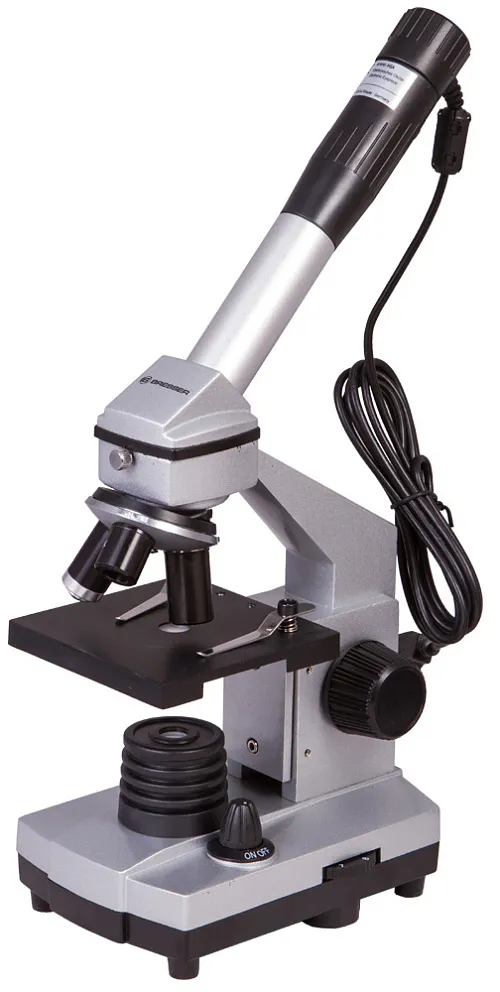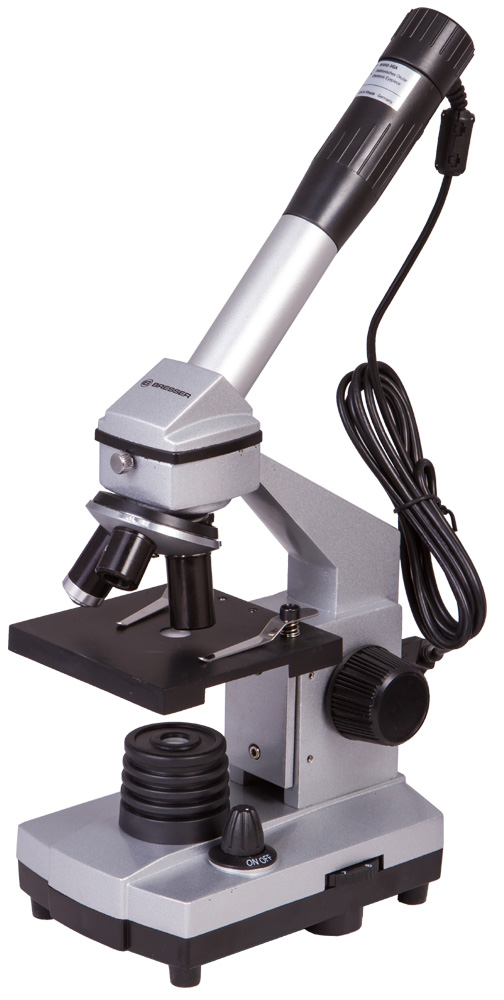Bresser Junior 40–1024x Microscope, without Case
Magnification: 40–1024x. Experiment kit included
Monocular
The microscope head is a core element of the microscope that you look through to see a magnified sample
40 — 1024
How much the size of a sample increases when you observe it through a microscope
School/educational
Application and use of the microscope
| Product ID | 26753 |
| Brand | Bresser GmbH, Germany |
| Warranty | 2 years |
| EAN | 4007922197616 |
| Package size (LxWxH) | 15x40x27 cm |
| Shipping Weight | 1.697 kg |
Description
Bresser Junior 40x–1024x is more than just a classical microscope. This microscope is processed very durable, it is versatile and can be connected to the computer conveniently!
Features:
- Extensive microscope set with varied accessories
- USB eyepiece for connecting a PC
- Bright LED illumination
- Image editing software
- Magnification: 40x–1024x
- 2 wide field eyepieces (WF10x and WF16x)
- 3 objective lenses (4x, 10x, 40x)
- Color: silver/black
The kit includes:
- Microscope
- Wide field eyepieces
- Objective lenses
- Barlow lense
- USB camera
- 10 slides
- 10 coverslips
- 5 prepared slides
- Pipette
- Tweezers
- Shrimp hatchery
- Mounting medium
- Software
- 3 AA batteries
- User manual
Specifications
| Product ID | 26753 |
| Brand | Bresser GmbH, Germany |
| Warranty | 2 years |
| EAN | 4007922197616 |
| Package size (LxWxH) | 15x40x27 cm |
| Shipping Weight | 1.697 kg |
| Type | biological, light/optical |
| Microscope head type | monocular |
| Magnification, x | 40 — 1024 |
| Eyepiece tube diameter, mm | 20 |
| Eyepieces | WF10x, WF16x, video eyepiece |
| Objectives | 4x, 10x, 40x |
| Revolving nosepiece | for 3 objectives |
| Stage features | with clips |
| Illumination | LED |
| Power supply | 3 AA batteries (included) |
| User level | elementary |
| Application | school/educational |
| Illumination location | lower |
| Research method | bright field |
| Experiment kit included | ✓ |
| Digital camera included | ✓ |
| Barlow lens | 2x |
| System requirements | Windows XP/Vista/7/10 (32 and 64 bit); 1.6GHz or above, 1GB RAM, 2GB hard drive, USB 2.0, CD/DVD-ROM |
Reviews
Frequently Asked Questions – Microscopes (20.04.2020)
We have gathered answers to the most frequently asked questions to help you sort things out
We have gathered answers to the most frequently asked questions to help you sort things out
Eye under a microscope: insects’ photo (20.04.2020)
Find out why studying eyes under a microscope is entertaining; how insects’ and arachnids’ eyes differ and what the best way is to observe such an interesting specimen
Find out why studying eyes under a microscope is entertaining; how insects’ and arachnids’ eyes differ and what the best way is to observe such an interesting specimen
What does hair look like under a microscope? (17.05.2020)
Read this review to learn how to observe human hair, what different hair looks like under a microscope and what magnification is required for observations
Read this review to learn how to observe human hair, what different hair looks like under a microscope and what magnification is required for observations
How does the aperture of a microscope objective lens work? (17.05.2020)
Learn what a numerical aperture is and how to choose a suitable objective lens for your microscope here
Learn what a numerical aperture is and how to choose a suitable objective lens for your microscope here
A spider under a microscope: photos and peculiarities of studying the slide (18.05.2020)
Learn what a spider looks like under microscope, when the best time is to take photos of it, how to study it properly at magnification and more interesting facts about observing insects and arachnids
Learn what a spider looks like under microscope, when the best time is to take photos of it, how to study it properly at magnification and more interesting facts about observing insects and arachnids
What does a microscope consist of? (18.05.2020)
This review for beginner explorers of the micro world introduces you to the optical, illuminating and mechanical parts of a microscope and their functions
This review for beginner explorers of the micro world introduces you to the optical, illuminating and mechanical parts of a microscope and their functions
Paramecium caudatum - your first friend from the microworld (21.11.2016)
Short article about Paramecium caudatum - a microorganism that is interesting to observe through any microscope
Questions and Answers
Submit your question/feedback

















